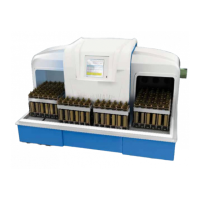
Do you have a question about the SCP SCIENCE NOVAWAVE and is the answer not in the manual?
| Type | Microwave Digestion System |
|---|---|
| Vessel Volume | up to 75 mL |
| Temperature Control | Yes |
| Pressure Control | Yes |
| Microwave Power | 1500 W |
| Frequency | 2450 MHz |
| Turntable | Yes |
| Power Output | 1500 W |
| Timer | Yes |
| Voltage | 230 V |
| Safety Features | Over-pressure protection |
| Display | Digital display |
Procedure for removing the NOVAWAVE system from its packaging.
Verifying that all components are included and checking for any shipping damage.
Overview of the NOVAWAVE system, including Model SA and Model FA differences.
Guidelines for selecting a suitable and safe location for the NOVAWAVE system.
Steps for installing the stand-alone NOVAWAVE SA system and staging tables.
Steps for installing the automated NOVAWAVE FA system, including transporter modules.
Critical safety measures to prevent excessive microwave energy exposure.
Explanations of symbols, CAUTION, WARNING, and NOTE messages in the manual.
Details on quartz digestion vessels, calibration, and safety warnings for damaged vessels.
Procedure for placing vessels into the transfer rack and securing them with caps.
Process of loading a prepared rack into the instrument's staging table and tunnel.
Procedures for cooling, venting vessels, and removing racks after digestion.
Overview of the three password-protected user levels: Operator, Administrator, and Service.
How to create a digestion 'cycle' by adding racks with the same method.
Procedure for selecting and adding multiple racks (up to 32) to a cycle.
Step-by-step guide to assigning methods and vessel types to individual sample positions.
Methods for entering individual Sample IDs via the Sample List or barcode reader.
Starting and monitoring the digestion cycle, including rack insertion.
Introduction to the tab for designing and managing heating profiles.
Real-time monitoring of sample temperatures during the digestion process.
Options to create, edit, copy, delete, and view digestion methods.
Interface for adding reagents and their volumes to a new digestion method.
Entering time-to-temperature and set point temperature values for a method.
Configuring cooling parameters by time or temperature for the method.
Retrieving detailed temperature profiles and run information.
Options for deleting runs, adding comments, and saving data to USB.
Understanding the graphical representation of digestion temperature profiles.
Using the Status tab to initialize system components and verify readiness.
Verifying the home position of doors, applicators, and tunnel status.
Initiating the calibration process by reading new thermopile data.
Uploading verified calibration data to the system's CPU.
Storing calibration data locally on the GUI or to a USB key.
Verifying proper connection and power for the calibration device.
Monitoring calibration progress and understanding warnings like tube type.
Window for managing user accounts, privileges, and passwords.
Process for creating new user accounts and assigning privileges.
Setting passwords and user information for newly added accounts.
Changing user group privileges from Operator to Administrator.
Setting date, time, language, and network parameters for the system.
Configuring how long reports are retained before being purged.
Methods for updating the NOVAWAVE software via server or USB.
Changing the system mode between Fully Automated (FA) and Stand Alone (SA).
Using the Log tab to review collected data for troubleshooting.
Utilizing the Operations tab to test individual system components.
Exiting the current session to return to the main interface.
Accessing the calibration screen via the Open Desktop option.
Procedures for rebooting the system or shutting down the GUI.
Procedures for washing and drying quartz and fluoropolymer vessels.
Replacing and cleaning fluoropolymer liners, caps, and safety pressure caps.
Information on safety cap calibration and recommended service intervals.
Procedures for cleaning the digestion tunnel and the bottom of the rack.
Routine cleaning of the graphical user interface screen.
Information regarding the product warranty period and conditions.
Essential safety practices for operating the NOVAWAVE in a laboratory environment.
List of potential safety messages and their causes during operation.
Specific safety messages related to the power management board.
Visual example of a safety message displayed during a digestion run.
Procedure for stopping a digestion and handling safety messages.
Operating specifications for humidity, altitude, and temperature.
Voltage, current, wattage, and frequency specifications.
Details on fuse types, ratings, and locations.
Comprehensive list of system error messages and their descriptions.